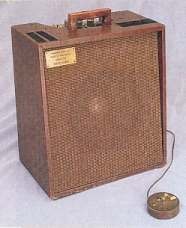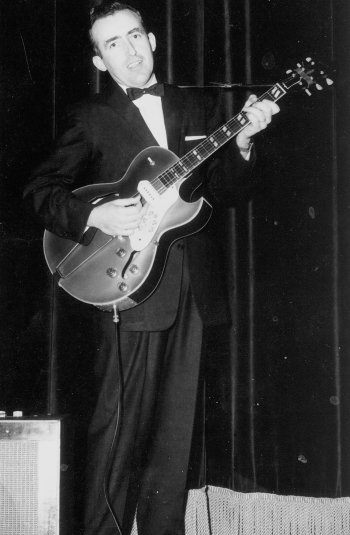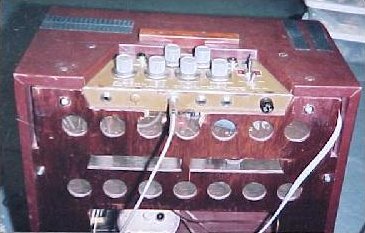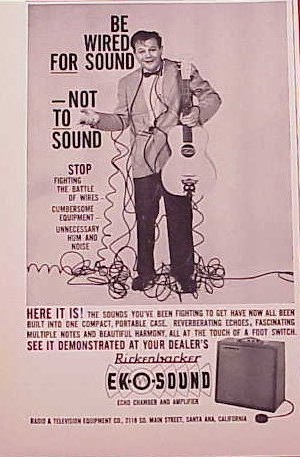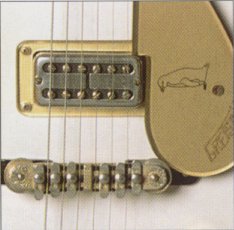 |
An Interview with Ray Butts This interview with Ray Butts originally appeared in the November 94 issue of Vintage guitar magazine. It is included here on Scotty's website to provide further background info about the history of his famous custom built EchoSonic amplifier and the custom pickups he currently uses and mainly because the issue it appeared in is no longer in print and it does not exist online anywhere else known. Ray Butts Ray Butts: No, I’m an accordion player, but I’ve
always had an interest in electronics, so when they electrified the guitar,
naturally, I got interested. I owned
a music store, Ray Butts’ Music in Did you ever play professionally? Yes. I moved to
That’s what I call long hours! Well, it’ll either make a good player out of you or kill
you! (laughs) Is that when you opened the music store? No, I went to work as a warranty repairman for a gentleman
who ran an appliance store. I
serviced all of his GE products, washing machines, radios, etc.
He offered to set me up with a shop and pay the utilities and so forth,
so it was a pretty good deal for me. I
did that for awhile and then decided to open my own place.
Is that where you came up with the EchoSonic amp? Yes. I knew a
guitar player names Bill Gwaltney who just loved Les Paul and wanted to get all
of that sound-on-sound stuff going, so I tried to build him an amplifier that
would do that. I had an old Gibson
with two 6V6’s, probably about 15 watts and experimented first with a wire
recorder. The only problem that
thing had was the wire had to be tied together in a loop and when the knot would
go across the head, it made a click, click, click.
I searched all over trying to find a continuous loop, with no luck and
then got the idea to use a tape unit. At
one point, I tried using two phonograph pickups connected by a spring, but the
tape unit worked best. Photo © courtesy Bill Gwaltney How did Chet Atkins become interested in your amp? I drove down to
photo courtesy D. Kyle How much did an EchoSonic sell for? I think about $495 at that time.
You know he always wrote his name in the back of his amp in case anything
happened. When word got out around
back home that I had one of Chet Atkins’ amps, boy it didn’t take long to
sell it. I tried tracking it down
once, but wasn’t able to. He was
also the first to use one of my amps on a Network TV program.
Chet was on the Ernie Ford Show and Ernie made the remark “I think Chet
has a little man in there who wiggles the tubes.”
He then asked Chet where he got the amp and he replied “An old boy down
in
You sold them amps too? Yes, they came in my shop together.
They were returning from a tour in I know Scotty Moore, Elvis’ first guitar player used
an EchoSonic, anyone else we might recognize? Yes, you know Scotty still owns his.
The first ones I made, the grill cloth was flush with the front of the
amp. He was playing a show with
Elvis in
photo courtesy D. Kyle How many Echosonics did you make in all? About 68 I think. They’re
pretty rare (points to picture of Elvis with Scotty Moore using EchoSonic) what
do you suppose that one’s worth? (chuckles). Did Rickenbacker borrow your idea for their echo style
amps? That’s right. F.C.
Hall had his own airplane, a light single engine, which he flew into
When did you finally move to Nashville
? That was in 1962. In
the early fifties I had begun designing a guitar pickup that Chet liked.
He had an endorsement with Gretsch at that time and suggested to them
that they use my pickups on their Chet Atkins model.
He said the DeArmonds they were using had too much bass for his style of
playing. I used the parts from those
DeArmonds to put these first pickups in because I hadn’t
had one designed yet. I had
to take a trade-in to have the parts for rebuilding.
The same with the new Butts pickups, at first I had to take humbuckings
in trade to have the parts for rebuilding. Of
course now I have all new parts of my own. Were these first pickups for Gretsch the Filter Trons? That’s right. I
made a handshake agreement with Fred Gretsch and he held up his end until the
day he died. You see, there wasn’t
anything in writing, so after he died, it took me a while to get a royalty
check! I made enough money to keep
groceries on the table, but I wasn’t getting rich or anything.
I also invented a stereo pickup for a guitar they built called the White
Falcon. Photo© courtesy T. Bacon "The Ultimate Guitar Book" How did you learn about building guitar pickups? Well, I understood the basic principal of wrapping wire
around a magnet. I also knew from
working on transformers that if they’re wound in opposite directions, one
cancels the hum from the other. So I
just did the same thing winding pickups. I
believe Gibson and I were working on this at about the same time.
I patented mine in 1954. Did you work as an engineer for RCA when you first moved
here? Well, when I first moved here, I didn’t have a job
really. Chet used to spend a lot of
time at RCA’s Studio B and I stopped by to see him one day.
He asked what I was doing and I told him.
He called up Sam Phillips of Sun Records who owned a studio over on
Seventh Avenue North run by (Nashville producer) Billy Sherrill.
He told Sam that I was in town and somebody was going to snap me up, that
if he wanted me he’d better hurry. So
I went for an interview and started working for him. When did you start with RCA? I think it was around 1970.
I did maintenance on all their recording equipment in four studios, A, B,
C and D. I also designed and
installed their headphone monitoring system, a three channel stereo mix going to
the studio so they could adjust individual volumes, the lead singer, backing
music and what they were recording at the time usually.
I also did some engineering, etc. You had a chance to meet with Paul Bigsby once, right? I met Paul while I was still living in Tell us about your Butts pickups. I have it in my mind to build the perfect jazz pickup –
and I will! I make each one
individually with the thought in mind to build them specifically for what I’m
wanting at the time. I have thought
about naming them using the “SONIC” since I’m known as the inventor of the
EchoSonic, such as JazzSonic, obviously for jazz, NovaSonic, for the ones I make
for Chet’s style of picking and plectraSonic, for players who use a pick.
That Gretsch you were playing a while ago was given to me by the Gretsch
company years ago. It has what I
call MelloSonic in it. What do you
think of it? I love it! It’s for a softer sound.
I can make anything a player wants, really.
That is the first one I ever built in that guitar.
The other Gretsch is a kind of experimental guitar I used to use to try
different pickups out on. Do you make an acoustic pickup too? Not Really. I
think I did make the first one though. In
about 1968 I got the idea to use piezos to pick up a signal from each individual
string. I put one on this old Stella
but I couldn’t get anybody interested. I
showed it to Chet, but it was too percussive, you could hear the thumb pick he
likes to use too loudly, so I just let it drop. This is great! Much
more bass response as well as clearer treble and midrange settings.
Is Gibson looking at these? I tried working something out with them, but we couldn’t
come to any agreement that satisfied both of us. Anything else you’re working on that we may see in the future? Oh, always something. I’m
working on a testing instrument for electronics that I’ve just talked to a
patent lawyer about, so I can’t say much about it yet.
I’ve had some rather large concerns express an interest in it when its
ready though. Well thanks for your time Ray.
I’ve really enjoyed it. Thank you. Stop
by and see me any time. How can somebody reach you if they’re interested in
your pickups or preamp? I need to have a brochure made up!
I stay so busy with all this other stuff, I just haven’t taken the
time. They can write me at This interview originally appeared in Vintage Guitar Magazine’s Nov ’94 issue and is now out of print. It is reprinted here with permission by Dave Kyle ** Ray passed away on April 20, 2003. To
quote Dave Kyle "This is indeed sad news. He was a marvelous inventor
and one of Nashville's unsung heroes. Even though he was only known in small
circles, his inventions spoke loudly to the entire world" |
